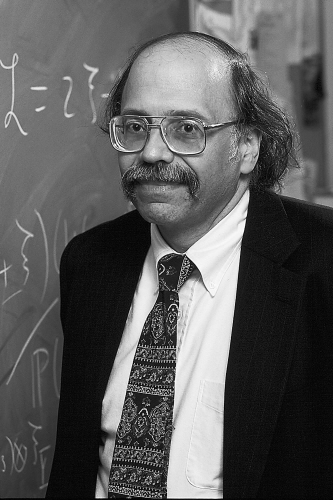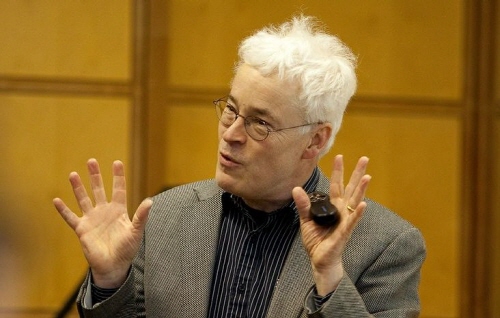|
Title: Computer Discovery and Visual Theorems in Mathematics
Speaker: Jonathan M. Borwein, University of Newcastle, NSW, Callaghan 2308, Australia
Abstract:
Long before current graphic, visualisation and geometric tools were available,
John E. Littlewood, 1885-1977, wrote in his delightful Miscellany:
A heavy warning used to be given [by lecturers] that pictures are not rigorous; this has never had its bluff called and has permanently frightened its victims into playing for safety.
Some pictures, of course, are not rigorous, but I should say most are (and I use them whenever possible myself). [L, p. 53]
Over the past five years, the role of visual computing in my own research has expanded dramatically.
In part this was made possible by the increasing speed and storage capabilities---and the growing ease of programming---of modern multi-core computing environments [BMC].
But, at least as much, it has been driven by my group¡¯s paying more active attention to the possibilities for graphing, animating or simulating most mathematical research activities.
I shall describe diverse work from my group in transcendental number theory (normality of real numbers [AB3]), in dynamic geometry (iterative reflection methods [AB]), probability (behaviour of short random walks [BS, BSWZ]), and matrix completion problems (especially, applied to protein confirmation [ABT]).
While all of this involved significant numerical-symbolic computation, I shall focus on the visual components.
Key References and URLS
[AB] F. Aragon and J.M. Borwein, ¡°Global convergence of a non-convex Douglas-Rachford iteration.¡± J. Global Optimization. 57(3) (2013), 753-769. DOI 10.1007/s10898-012-9958-4. See also
[AB3] F. Aragon, D. H. Bailey, J.M. Borwein and P.B. Borwein, ¡°Walking on real numbers.¡± Mathematical Intelligencer. 35(1) (2013), 42-60. DOI: http://link.springer.com/article/10.1007%2Fs00283-012-9340-x. See also http://walks.carma.newcastle.edu.au/.
[ABT] F. Aragon, J. M.Borwein, and M. Tam, ¡°Douglas-Rachford feasibility methods for matrix completion problems.¡± ANZIAM Journal. Accepted March 2014. Available at http://arxiv.org/abs/1308.4243. See also http://carma.newcastle.edu.au/DRmethods/.
[BSC] J.M. Borwein, M. Skerritt and C. Maitland, ¡°Computation of a lower bound to Giuga's primality conjecture.¡± Integers 13 (2013). Online Sept 2013 at #A67, http://www.westga.edu/~integers/vol13.html.
[BS] J.M. Borwein and A. Straub, ¡°Mahler measures, short walks and logsine integrals.¡± Theoretical Computer Science. Special issue on Symbolic and Numeric Computation. 479 (1) (2013), 4-21. DOI: 10.1016/j.tcs.2012.10.025.
[BSWZ] J.M. Borwein, A. Straub, J. Wan and W. Zudilin (with an Appendix by Don Zagier), ¡°Densities of short uniform random walks.¡± Can. J. Math. 64 (5), (2012), 961-990. http://dx.doi.org/10.4153/CJM-2011-079-2.
[L] J.E. Littlewood, A mathematician's miscellany, London: Methuen (1953); Littlewood, J. E. and Bollobas, Bela, ed., Littlewood's miscellany , Cambridge University Press, 1986.
|
|
Title: Soft Math Math Soft
Speaker: Bruno Buchberger, Johannes Kepler University, Austria
Abstract:
In this talk we argue that mathematics is essentially software. In fact, from the beginning of mathematics, it was the goal of mathematics to automate problem solving. By systematic and deep thinking, for problems whose solution was difficult in each individual instance, systematic procedures were found that allow to solve each instance without further thinking. In each round of automation in mathematics, the deep thinking on spectra of problem instances is reflected by deep theorems with deep proofs.
In 20th century, the systematic procedures for spectra of problems became physically tangible as algorithms / software for the universal computer (which itself essentially is a mathematical invention). In 21st century, the rounds of automation in mathematics reach higher and higher levels and move more and more to the meta-level of mathematics, i.e. to the automation of mathematical thinking itself.
In this talk, we illustrate the evolution of mathematics towards higher and higher levels of automation of its own problem solving and thinking process by a couple of examples of increasing sophistication starting from calculation with Roman numbers up to the automatic invention of algorithms like the speaker¡¯s algorithm for computing Gröbner bases.
As a practical experience of Gödel¡¯s Incompleteness Theorem, there is no upper bound to the sophistication of higher and higher rounds in mathematical automation. Thus, mathematicians live in the best of all worlds: They can embark on more and more challenging problems that need an algorithmic solution knowing that, after an algorithmic solution has been achieved, there will always be room for more sophistication and human mathematical invention. Thus, in a sense, mathematicians will never become jobless.
By the intellectual power in the automation of mathematical problem solving, visible as ¡°software¡±, mathematics is also in the center of the spiral of automation in all science, technology and economy and is the silent driving force behind the spiral of innovation.
Unfortunately, the intellectual attractiveness and practical relevance of mathematics is hard to explain to outsiders. Or, more precisely, mathematicians often do a very bad job for explaining the fundamental role of mathematics clearly enough to outsiders, who in fact are the insiders of modern society. However, it is very important for the further development of mathematics that the role of mathematics for modern science, technology, economy, and welfare is made public. We will also present a few ideas about this political aspect of being a mathematician in today¡¯s society.
|
|
Title: Numerical Algebraic Geometry: Theory and Practice
Speaker: Andrew Sommese, University of Notre Dame, USA
Abstract:
The goal of Numerical Algebraic Geometry is to carry out algebraic geometric
calculations in characteristic zero using numerical analysis algorithms.
This comes down to numerical algorithms to compute and manipulate solution
sets of polynomial systems. Numerical Algebraic Geometry is a natural
outgrowth of the continuation methods to compute isolated complex solutions
of systems of polynomials with complex coefficients. There are a wide range
of applications including solution of chemical systems, kinematics, numerical
solution of systems of nonlinear differential equations, and computation of
algebraic geometric invariants.
Bertini is open-source C software, developed by Bates (Colorado State U.),
Hauenstein (Notre Dame), Sommese (Notre Dame), and Wampler (General Motors R.
& D.), to carry out Numerical Algebraic Geometry computations. Bertini will
be rewritten to make it a better tool for users. Bertini dates from over a
decade ago, and from this experience we have identified several
possibilities for significant improvements. One goal is to change some
of the data structures and add internal functionality that will give the user
the ability to write scripts and interface with other software.
In this talk, I will give an overview of Numerical Algebraic Geometry. I will
consider the theoretical algorithms underlying the area in the light of the
practical issues that arise when implementing the algorithms in the current
and the future Bertini.
|
|
Title: Principle of Independence for Robust Geometric Software Learned by the Human Visual Computation
Speaker: Kokichi Sugihara, Meiji University, Tokyo, Japan
Abstract:
Straightforward implementation of geometric algorithms usually results in unstable software
because numerical errors generate inconsistency and make the software to fail. The human brain,
on the other hand, can manage image data robustly although the resolution, precision and
computation speed are all poor when compared with the electric computers. In this talk we try to
characterize the sources of the robustness of the human visual computation through optical illusion,
and consider to utilize them for designing robust geometric software. In particular we point out that
the human brain is persistent and similar persistency can be implemented to make geometric software robust.
In other words, we treat only independent set of information and thus avoid inconsistency.
This idea includes the topology-oriented approach which we have studied for robust geometric computation.
|
|
Title: CHEBFUN AS A SOFTWARE PROJECT
Speaker: Lloyd N. Trefethen, University of Oxford, UK
Abstract:
Chebfun is a software system for numerical computation with functions.
The starting point in 2002 was the idea of overloading Matlab's discrete objects (vectors, matrices,...)
to continuous analogues (functions, operators,...). For speed and robustness, however, everything remains numerical,
based on piecewise Chebyshev expansions. Thus another way to view Chebfun is as an extension of
the rounding-to-16-digits idea of floating point arithmetic from numbers to functions.
From this starting point, Chebfun has moved in many directions, including linear and nonlinear ODEs,
time-dependent PDEs, edge-detection, computation with functions defined on rectangles in 2D,
quadrature and orthogonal polynomials, Legendre-Chebyshev conversions, rootfinding in 1D and 2D, and rational approximation.
Besides its convenience for practical desktop computing, it is also an excellent tool for exploring many topics of approximation theory.
Though this talk will touch on these mathematical topics, the organizing principle will be software.
How does a project like this evolve over a decade from one programmer and his PhD supervisor to a dozen developers
linked by GitHub with users around the world? How do you keep the project under control and make it strong for the future
even when most of the work is done by students and postdocs passing through transiently and busy building their research careers?
These challenges are new to me in the past decade, and I have as many questions as answers.
|





